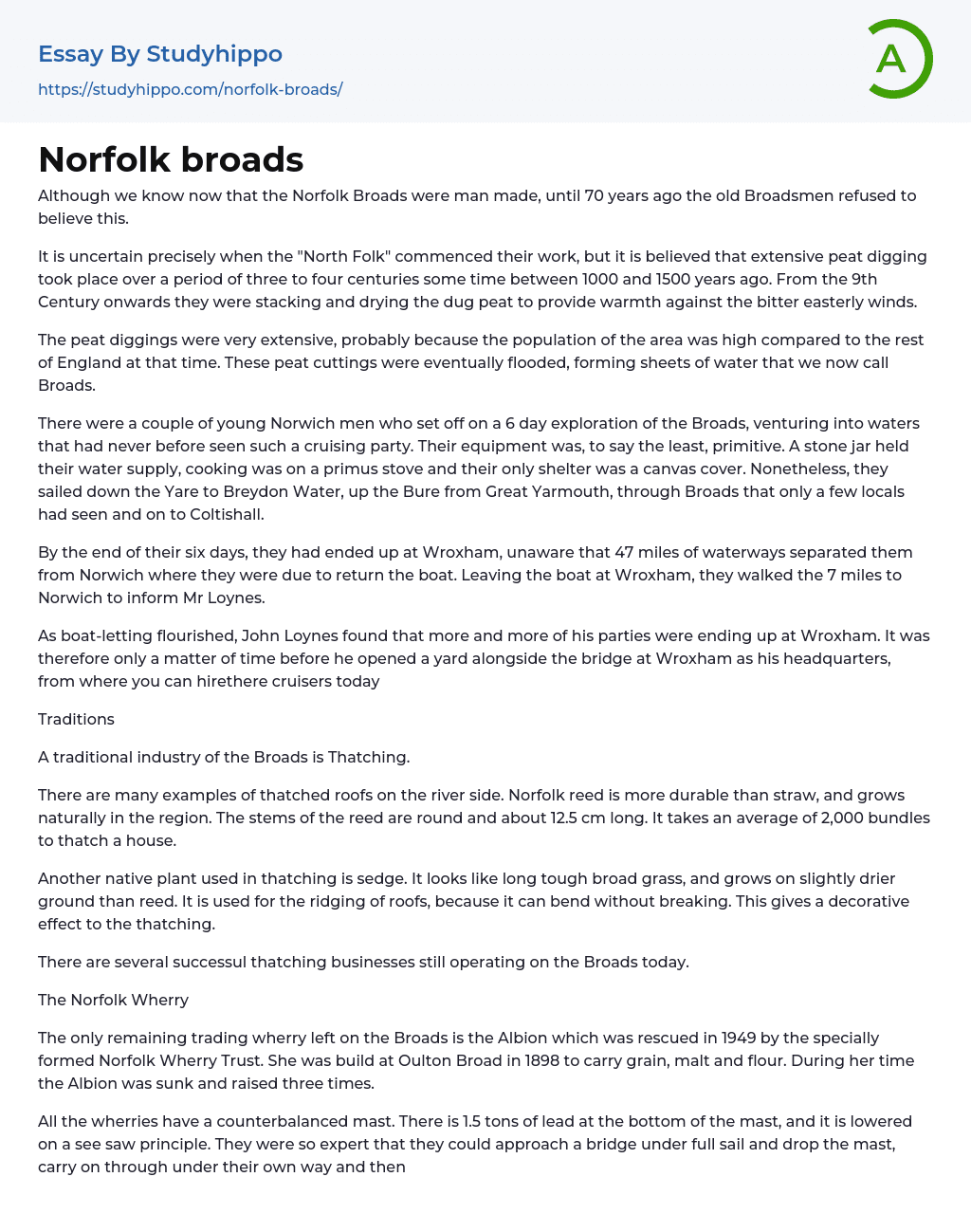Despite the fact that the Norfolk Broads were created by humans, for 70 years the old Broadsmen vehemently denied this truth.
It is unclear when exactly the "North Folk" began their work, but it is believed that a significant amount of peat digging occurred for a duration of three to four centuries between 1000 and 1500 years ago. Starting from the 9th Century, they would stack and dry the excavated peat in order to stay warm against the harsh easterly winds. The peat diggings were quite extensive, likely due to the relatively high population of the area in comparison to the rest of England during that time. These peat cuttings eventually became flooded, resulting in the formation of water bodies now known as Broads.
Two young men from Norwich embarked on a 6-day expedition of the Broads, exploring waters th
...at had never before been traversed by a cruising party. Their equipment was rudimentary, with a stone jar serving as their water supply and a primus stove for cooking. Their only form of shelter was a canvas cover. Despite these limitations, they navigated the Yare to Breydon Water and ventured up the Bure from Great Yarmouth. They passed through Broads that were largely unfamiliar to the locals and eventually reached Coltishall. Unbeknownst to them, there were 47 miles of waterways separating them from Norwich, their intended destination to return the boat. Leaving the boat behind at Wroxham, they walked the 7 miles back to Norwich to inform Mr. Loynes.
John Loynes opened a boat rental yard at Wroxham as his main base, where you can still hire cruisers today. Thatching is a traditional industry on the Broads, with man
examples of thatched roofs along the riverside. Norfolk reed, which grows naturally in the region, is used for thatching as it is more durable than straw. The reed stems are round and approximately 12.5 cm in length. It takes around 2,000 bundles of reed to thatch a house.
Another native plant utilized in thatching is sedge, resembling long, resilient grass that thrives on somewhat drier terrain than reed. Its flexibility makes it ideal for ridge decoration on rooftops, as it can be bent without snapping. Today, there are several thriving thatching businesses in operation on the Broads. The Albion, rescued in 1949 by the specially established Norfolk Wherry Trust, is the sole surviving trading wherry on the Broads.
The Albion was built in 1898 at Oulton Broad to transport grain, malt, and flour. Throughout its existence, it faced three separate incidents of sinking and subsequent raising. It is worth noting that all wherries possess a mast with a counterbalance system. At the base of the mast, there is approximately 1.5 tons of lead, which is lowered using a see saw principle. The crew exhibited extraordinary skill by being able to glide under a bridge with the sail fully deployed, swiftly lowering the mast just in time to pass through, and promptly raising it once they were on the other side.
They did not cease at all. Some of the wherries had the ability to navigate through shallow rivers by detaching their keel and reattaching it on the way back. The range of boats available for couples is exceptional. For those new to boating, there are small and cozy boats. Honeymooners or more experienced boaters can opt for larger
and more luxurious two-berth boats. For groups of couples, there are boats with two en-suite cabins or boats with four double cabins.
Families, We strive to offer boats that can accommodate each family member with ample space and privacy. For families with young children, we suggest single level boats with lockable doors to ensure parental peace of mind. As the children grow and start bringing their friends along, additional single beds can be arranged. In the case of two families with children wanting to share a boat, we recommend two double cabins and two twin cabins. For large parties and groups, we have boats available that can accommodate a substantial number of berths.
We offer boats that can accommodate up to eleven people, including two people on the extra settee berth, providing excellent value per person. When it says "Sleeps 4 - 6", it means that the boat has 4 standard berths and 2 additional berths. While the boat is ideal for 4 people, it is possible to sleep an additional 2 people with some inconvenience. The extra berths are typically found on a convertible settee/berth.
- John Locke essays
- 9/11 essays
- A Good Teacher essays
- A Healthy Diet essays
- A Modest Proposal essays
- A&P essays
- Academic Achievement essays
- Achievement essays
- Achieving goals essays
- Admission essays
- Advantages And Disadvantages Of Internet essays
- Alcoholic drinks essays
- Ammonia essays
- Analytical essays
- Ancient Olympic Games essays
- APA essays
- Arabian Peninsula essays
- Argument essays
- Argumentative essays
- Art essays
- Atlantic Ocean essays
- Auto-ethnography essays
- Autobiography essays
- Ballad essays
- Batman essays
- Binge Eating essays
- Black Power Movement essays
- Blogger essays
- Body Mass Index essays
- Book I Want a Wife essays
- Boycott essays
- Breastfeeding essays
- Bulimia Nervosa essays
- Business essays
- Business Process essays
- Canterbury essays
- Carbonate essays
- Catalina de Erauso essays
- Cause and Effect essays
- Cesar Chavez essays
- Character Analysis essays
- Chemical Compound essays
- Chemical Element essays
- Chemical Substance essays
- Cherokee essays
- Cherry essays
- Childhood Obesity essays
- Chlorine essays
- Classification essays
- Cognitive Science essays




